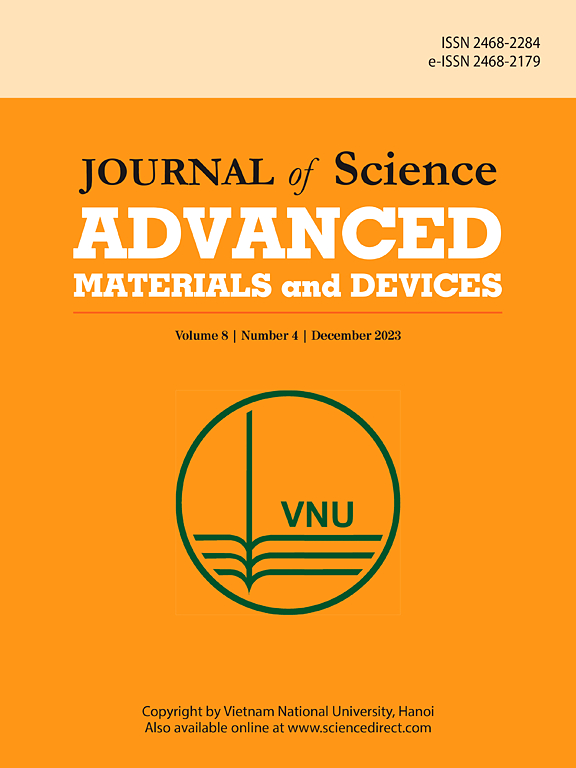测量电流对磁性纳米结构中各向异性磁电阻计算的影响
IF 6.7
3区 材料科学
Q1 MATERIALS SCIENCE, MULTIDISCIPLINARY
Journal of Science: Advanced Materials and Devices
Pub Date : 2024-12-30
DOI:10.1016/j.jsamd.2024.100838
引用次数: 0
摘要
利用多尺度方法,我们研究了测量电流对计算出的纳米结构各向异性磁电阻的影响,这些各向异性磁电阻是由微磁编码获得的磁化构型推导出来的。我们分析了标准程序中固有的微妙的隐含假设和可能被忽视的近似,这些近似在很大程度上忽略了样品内电流的不均匀分布和电流本身产生的磁场。作为初步研究,我们回顾了从计算的磁化分布中确定电阻的各种方法。然后,我们重点研究了由于不同的局部磁化方向而引起的电阻率变化所产生的不均匀电流分布的影响。最后,我们评估了由测量电流产生的磁场的意义。为了进行这些分析,我们开发了自一致的程序,使用MuMax3和COMSOL Multiphysics的拉普拉斯方程迭代求解微磁问题。总的来说,我们的结果验证了直接从微磁码提供的磁化角度计算各向异性磁电阻的标准方法,特别是对于典型的(小)磁电阻系数值。然而,我们证明具有较大AMR系数的材料可能需要更复杂的计算方法。与实验结果比较的一个重要方面是电接触的分析,其中测量电流可以显着改变磁化分布,从而改变纳米结构的磁阻,即使是小的AMR系数。本文章由计算机程序翻译,如有差异,请以英文原文为准。
The influence of measuring current on the calculation of anisotropic magnetoresistance in magnetic nanostructures
Using a multiscale approach, we investigate the influence of measuring current on the calculated anisotropic magnetoresistance of nanostructures, derived from the magnetization configuration obtained with micromagnetic codes. We analyze the subtle implicit assumptions and potentially overlooked approximations inherent in standard procedures that largely disregard the inhomogeneous distribution of electric current within the sample and the magnetic field generated by the current itself. As a preliminary study, we review various methods for determining resistance from the calculated magnetization distribution. We then focus on the impact of non-uniform current distribution arising from variations in resistivity due to different local magnetization orientations. Finally, we assess the significance of the magnetic field produced by the measuring current. For these analyses, we develop self-consistent procedures that iteratively solve the micromagnetic problem using MuMax3 and the Laplace equation with COMSOL Multiphysics. In general, our results validate the standard approach of calculating anisotropic magnetoresistance directly from the angle of the magnetization provided by micromagnetic codes, especially for typical (small) values of the magnetoresistance coefficient. However, we demonstrate that materials with larger AMR coefficients may require more sophisticated calculation methods. An important aspect for comparison with experimental results is the analysis of electrical contacts, where the measuring current can significantly alter the magnetization distribution and, consequently, the magnetoresistance of the nanostructure, even for small AMR coefficients.
求助全文
通过发布文献求助,成功后即可免费获取论文全文。
去求助
来源期刊

Journal of Science: Advanced Materials and Devices
Materials Science-Electronic, Optical and Magnetic Materials
CiteScore
11.90
自引率
2.50%
发文量
88
审稿时长
47 days
期刊介绍:
In 1985, the Journal of Science was founded as a platform for publishing national and international research papers across various disciplines, including natural sciences, technology, social sciences, and humanities. Over the years, the journal has experienced remarkable growth in terms of quality, size, and scope. Today, it encompasses a diverse range of publications dedicated to academic research.
Considering the rapid expansion of materials science, we are pleased to introduce the Journal of Science: Advanced Materials and Devices. This new addition to our journal series offers researchers an exciting opportunity to publish their work on all aspects of materials science and technology within the esteemed Journal of Science.
With this development, we aim to revolutionize the way research in materials science is expressed and organized, further strengthening our commitment to promoting outstanding research across various scientific and technological fields.
 求助内容:
求助内容: 应助结果提醒方式:
应助结果提醒方式:


